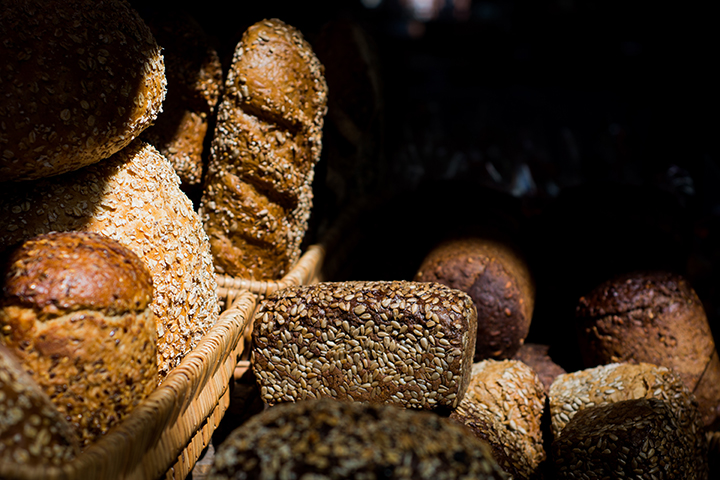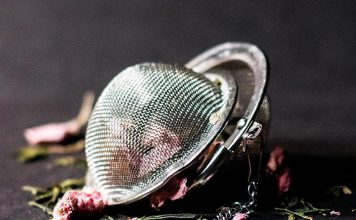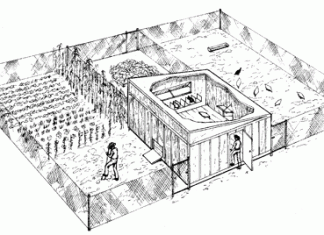 |
|
| Issue #112 • July/August, 2008 |
Bread baking is an ancient craft that some food historians believe reaches back over 15,000 years to the time when the last Ice Age was losing its grip on the earth, and soil that had been frozen hard for as many as 1000 centuries began to soften. Accounts by some paleontologists, depicting this time of receding ice sheets and warming climate, describe a wide variety of wild grasses and other edible plants that began to flourish. It didn’t take long for the hunter-gatherers of this time to discover that the seeds of these wild grasses were a valuable food source. They used mortars and mills hollowed out of rock to crush the wild grass seeds and mix them with water to make a crude, dense porridge which, by the way, was as nourishing as the cooked breads to follow.
The wonders of fire made it possible to cook this porridge into the first unleavened breads. Later, it was discovered that when porridge was set aside for a few days; it would ferment and become puffed up with gases. When the paste was cooked over an open fire, or on a hot stone, it became softer, lighter, and tasted better.
Later, the Egyptians made the connection between this leavening action in bread dough and the fermentation of beer. They discovered that barm, the brownish scum that forms on top of fermenting beer, could be used to leaven bread or start a new batch of brew. The long road to Wonder Bread and Bud Light had begun.
It’s worth noting that Wonder Bread introduced sliced bread into the American market in 1930. It did not take long before this pillow-soft bread, made with highly refined bleached and bromated flour, and treated with a variety of softeners and preservatives, dominated the market. But these breads are nutritionally inferior to breads made with whole grain flours.
|
A loaf of real bread can be made with the simplest imaginable ingredients: flour, yeast, salt, water, heat, and time. I list time as one of the basic ingredients because grain molecules need time to release their flavor and texture-producing components.
The reason commercial bakeries, like the people who make Wonder Bread, replace time with stabilizers, dough softeners, preservatives, and a long list of other chemicals, is cost. By replacing the healthful components with chemicals, production costs are minimized.
However, making a great loaf of bread is not at all complicated. The simplicity of this process, and benefits that can result from your efforts is, in my opinion, why bread has long been considered the “Staff Of Life.” Unfortunately, modern technology has transformed this once healthful food into a tasteless, artificially inflated ball of starch substantially depleted of vital nutrients. The FDA has approved 30 chemicals for addition to bread. If you pick up a loaf of commercial bread in your local market and read the label you will find additives like benzoyl peroxide (a chemical used in acne creams), calcium chloride, ammonium chloride, potassium bromate, and a host of other additives, many with unpronounceable names. What is known about all of these chemicals is that they bleach the flour and extend the shelf life of commercial breads. What is not known is their long-term toxic effects on humans.
Modern technology starts the nutritional depletion of the grain at the first processing stepgrinding the grain. Modern mills crush the grain with high-speed rollers that run at temperatures of nearly 400 degrees. Milling at these temperatures destroys many of the vitamins in the grain. Nutritionists, dietitians, and other health care professionals have been telling us for years that baked goods made with whole grains are healthier than those baked with highly refined flour.
When you are shopping for a good loaf of bread the term “whole wheat” is constantly being tossed at you. Much of this is deceptive marketing by commercial bread manufacturers. The term “whole wheat” on a loaf of commercial bread implies that the loaf is a healthful alternative to white bread. However, most loaves labeled “whole wheat” are the same old white bread with burnt sugar added, and listed on the label as “caramel.” (By the way, if it says “100% whole wheat,” it’s a much better alternative.) As a society we have been eating these commercial breads for so long that many of us have forgotten what real bread tastes like.
Quality whole grain bread is a heavier denser loaf than bread made with highly refined flour and chemical leaveners. It is also more expensive because you are paying for the extra grain and labor time that it takes to produce this bread. Unfortunately, sky rocketing prices for grains of all kinds are making it more difficult for many to afford a loaf of real bread.
What is the solution to this growing dilemma? Ideally, you could buy a grain mill and sacks of whole grain, grind this grain into flour, and quickly bake it into your bread of choice. If grain products continue to increase in price and their availability continues to shrink the way they are today, this may be the most cost-effective solution to your problem.
As ambitious as this sounds, it is possible, and not at all difficult. For years I made my own beer and ale by grinding whole grain malted barley to prepare it for mashing. The tool that made this possible was a small, inexpensive hand-cranked grain mill. I paid about $25, in 1980s dollars, for the package. After checking my old brewing records, this small mill produced enough cracked barley for 120 24-bottle cases of brew. If I were grinding wheat for bread I could produce enough whole grain flour to make about 15 loaves of bread at each grinding session.
I will discuss the use of the grain mill in more detail in the article that will follow this one. The mills on the market today are far more efficient and easier to use than the one that I had. I am ordering one of these new generation mills, and I will be using it to process whole grains for use in upcoming recipes.
But, we must start from the beginning. First things first, as my old mentor Chef Sully would frequently tell me. In this article I am going to review some of the essentials of baking bread. Even if you consider yourself a seasoned baker, I can assure you that there is something to learn here. The recipes I will share with you use many of the same techniques used by professional bakers from around the world.
As home bakers we have limitations on space, supplies, and equipment. Fortunately, some of the world’s most knowledgeable master bakers have revised successful bread baking techniques used in their shops and made them available to home baking enthusiasts. As a result, 100% whole grain breads can be made at home, using widely available ingredients and equipment found in most home kitchens. These breads are a far cry from the brick-like, leathery-crusted, spongy, gelatinous loaves that you may have produced, using old traditional methods. These breads look good and taste wonderful. All that is necessary is knowing how to evoke maximum flavor from the grain through the careful manipulation of quality ingredients, along with the management of time and the control of temperature. Control of time and temperature are two very important elements in making bread. As we move deeper into the world of whole grain breads, professional baking terms like autolyse (pronounced auto-leesit is a time element) and cold fermentation (temperature element) will be explained and applied to recipes. After baking a few loaves using these techniques, they will become second nature.
My mother taught me that having a recipe that produced great consistent results was all that any cook needed. However, 35 years of experiences has taught me that having a great recipe is only the beginning. Knowing what makes a recipe great is also important. The art of making a good loaf of bread requires that the baker know why certain mixtures of ingredients and blending techniques work while others don’t. I hope when this series of articles is complete, you will have the informational tools necessary to consistently make delicious whole grain and conventional breads.
The cost of these breads will be a fraction of what you will pay for a loaf of commercial bread. We are in a tough economic time that seems to be worsening. Bread is a basic food item humans have consistently turned to when times get tough. What could be better, in a time like this, than having the ability to produce the Staff of Life from basic ingredients that you have processed yourself and fashioned into great looking food for yourself and your family?
The basic elements of bread baking are straightforward and easy to understand. For those like me, who have developed a real passion for baking, there are some interesting mathematics and chemistry to learn also. But, for now, I think the basic elements will get us started and I’ll save the math and science for the next edition.
Elements of baking
Flours 101: Flour is the core ingredient in bread, and wheat is the grain of choice for making bread flour. There are other grains that can be used in conjunction with wheat to make a variety of interesting breads. But most bread requires wheat flour as a primary ingredient because it contains more gluten than other grains.
Milling crushes wheat berries into various degrees of powder. The whole berries contain three main components: the outer skin, called bran, the vitamin E-rich embryo or germ, and the protein-laden starch or endosperm.
|
Once ground, flour is sifted. The first sifting produces clear flour which contains whatever amount of bran and germ passed through. The seconding sifting produces patent, which is the flour you buy, bleached or unbleached, at the store.
The type of flour, i.e., the purpose for which it will be used, is determined by its protein content. (See sidebar.) But there are also several varieties of wheat from which the flour can be made: hard wheat and soft wheat, red wheat and white wheat, winter wheat and spring wheat. Wheat is blended at the mill from the various types of grain to produce the flours listed in the sidebar. Professional bakers often specify a specific blend in order to produce their bread of choice.
Why do I specify unbleached flour in my bread formulas? I will admit that good bread can be made from bleached flour. Many of the formulas that I will share with you are what bakers call lean breads. Lean breads, for the most part, use the basic four ingredients: flour, yeast, salt, and water. The taste and texture of the bread depends on using quality ingredients that are assembled, fermented, and baked so that maximum flavor and texture is extracted from the grain.
White flour is bleached flour. Bleaching removes the beta-carotene. Not only is the nutritional value of the flour reduced, it’s my opinion that beta-carotene contributes to a substantially better flavor and aroma in finished bread. I have made several breads formulated with both bleached and unbleached flour and submitted them side by side to my taste review committee, (Mom, along with our children Sarah, Jason, and Michael) without telling them which was which. The bread made with unbleached flour consistently won the taste, aroma, and appearance vote. When “enriched bread” (breads made with bleached flour that has additives) was tested this way the resulting breads were about even in appearance, aroma, and taste. I believe ingredients like fats, sugar, and molasses added to “enrich” the flour seem to mute the difference between the breads.
Measuring ingredients: All ingredients in a bread recipe must be carefully measured. This is crucial to success. Some folks are comfortable with scooping flour and eyeball-measuring water and other liquids. Others, like me, prefer the precision of weighing major ingredients like flour, water, milk, and other liquids. The relationship between the amounts of flour and liquid in a bread recipe greatly impacts the end result. Weighing the ingredients is the most accurate way of maintaining this delicate balance. I used a digital scale that is accurate to ¼ ounce to weigh the ingredients in all of the recipes that follow. The latest digital scales are not expensive. All of the models I tested were very accurate. I purchased mine at Wal-Mart for under $30.
Mixing the ingredients: Mixing can be done by hand or machine. I own a Kitchen Aid heavy-duty standing mixer that has a dough hook for mixing and kneading. However, I prefer mixing by hand because it helps me develop a feel for when dough is right and ready for the next processing step.
I designed all of the recipes in this article to produce only one loaf of bread. In the beginning, working with a small piece of dough makes it easier for a baker to concentrate on when the dough is right or needs adjustment. Getting your hands in the dough at the beginning is the best way to learn and master this important element of baking. As you go further down the prep line you will find that mistakes in ingredient ratios and methods of assembly become more difficult or impossible to correct. So, get them right at the beginning.
Resting the dough: The autolyse is a period of time that occurs just after the bread ingredients are mixed. During this time enzymes in the dough go to work extracting flavor-producing sugars from the grain molecule. It contributes a great deal to the production of a good loaf of bread and it also reduces kneading time. I have included an extended version of this technique in my first recipe. In this recipe the long rest almost, but not completely, eliminates kneading.
Kneading the dough: Gluten is the primary protein in wheat. It is composed of two partial proteinsgliadin and glutenin. When the flour is hydrated (water is added) these two proteins link up to form the complex protein gluten. However, this linking is disorganized, tangled, and very weak. Kneading pulls this twisted matrix apart and realigns it into straight and strong sheets. This makes it possible for the dough to trap the air bubbles formed by the interaction between the yeast and other wheat components. This step is critical to giving bread structure, otherwise, you wind up with unleavened, heavy bread with less flavor and poorer texture.
Fermenting the dough: During fermentation, yeast feeds on the starch in the wheat. This feeding releases carbon dioxide which is trapped by the fibers of gluten and gives the bread lift. With most recipes it is best to allow the dough to double in bulk before moving to the next step.
Degassing: Most bread recipes call this step “punching down the dough,” a term I find misleading. The primary purpose of this procedure is to redistribute the yeast and expose it to a new food source. Degassing is best performed by gently pressing down on the dough. This process will give breads intended for sandwiches that have the familiar “fine crumb” or texture we see in sandwich bread. It does not favor rustic breads that characteristically have a coarser “open crumb,” i.e., the large holes like we see in loaves like French bread. Rustic bread dough is best handled during this step by gently folding over on itself without applying excessive pressure.
Shaping the dough: This is simply forming the dough into the desired shape. It is best to do this on an unfloured work surface which allows the dough to grip the counter and makes shaping it easier.
Proofing the dough: This is the final rise before the bread is baked. The function here is to raise the dough to the appropriate size for baking. During this stage, controlling temperature is important. For the breads that I have included in the recipe section, 72° to 75° F (average room temperature) is ideal. Proofing at this temperature takes longer than proofing at higher temperatures. For example, the four breads in this article will proof fully in about 90 minutes at room temperature. Every 17 degrees above or below this effectively halves or doubles this time.
Whole grain breads develop the most flavor when proofed at room temperature or below. Professional bakers call this “a slow secondary fermentation.” Some bakers maximize flavor development in their breads by proofing them in the refrigerator overnight.
Baking the bread: Since residential ovens vary in their ability to develop accurate temperature and retain heat, I suggest using a baking stone or unglazed quarry tiles when baking most breads. Both tend to hold and distribute heat evenly, making baking times more predictable. They are most effective when positioned on an oven rack in the lower third of the oven.
Cooling the bread: Cooling newly baked bread on a rack allows moisture to escape from the bottom of the bread, preventing it from becoming soggy. Breads baked in a loaf pan should be removed from the pan as soon as possible after being taken from the oven.
|
Storing and eating your bread: Lean breads, those made with only flour, yeast, salt, and water, should only be stored in paper to preserve their crispy crust. However, these breads will be stale within a day when stored this way. If you want to preserve them longer, wrap them in plastic and then freeze them or keep them in a cool place.
Enriched breads, those containing butter, oil, milk, and sugar, should always be stored in plastic.
If you plan to eat a previously frozen loaf of bread, pull it from the freezer at least two hours before you plan to use it.
I prefer slicing a cooled loaf of sandwich-type bread before placing it in the freezer. This allows me to remove only the slices that I plan to use.
Before moving on to the recipes, here are some important facts that all home bakers will benefit from. In each article of this series, I will add to this list.
- Some folks believe that bread flour, readily found in most supermarkets, is best for most bread. But this is only partially true. Unbleached all-purpose flour is an excellent alternative for most recipes and you can experiment to decide which type you like best.
- Many bread books will instruct you to tap the bottom of the bread when testing for doneness. This method is a hit-or-miss proposition, especially when baking whole grain breads which are denser than breads made with white flour. Lack of precision here can result in underbaked breads. Measuring the temperature of a baked loaf with a digital instant-read thermometer is the best and most accurate way to test for doneness. Rustic breads are done when baked to an internal temperature of 210° F. Enriched breads are done when baked to an internal temperature of 195° F.
- For many years I thought that fresh yeast was the best yeast for bread. Well, times have changed. There is a new yeast heavyweight in town to which even my long trusted Active Dry Yeast takes a backseat. On most supermarket shelves it is labeled as Rapid Rise, Instant, or Bread Machine yeast. When kept in the refrigerator or freezer it stays fresh and active for months. It does not have to be hydrated before being incorporated into a recipe. You mix it directly with the flour and other dry ingredients.
- Some folks believe that salt is an optional ingredient in baking recipes. Please know that salt is essential. In bread baking it performs several critical functions. It controls yeast activity, strengthens gluten, and accents the bread’s flavor. Unless you feel that it is necessary to completely eliminate sodium from your diet, please don’t omit salt from your bread recipes.
- Tap water, depending on where you live, is a very unpredictable ingredient. In many areas of this country, tap water may contain minerals and additives that can adversely affect the flavor of bread. Bottled water is universally more reliable. Because of its popularity it is widely available and relatively cheap. If the water in your area smells and tastes good, feel free to use it in your breads. I listed bottled water in all of the recipes here. The only time where I feel that bottled spring water has no substitute is during the develop stages of a sourdough starter. This is when impurities in the water can have terminal consequences on the starter. Ignoring this simple safeguard left me with three starters, that, pardon the pun, never got started.
I think we have covered enough of the basics, so let’s move on to the recipes and bake some bread.
The recipes I am presenting here are not 100% whole grain formulas. Each recipe includes a carefully measured amount of unbleached all-purpose or bread flour.
As I said earlier, many of us have forgotten what real bread tastes like. We have embraced these soft pillow breads and unconsciously allowed our senses to adjust to these tasteless, chemically-soaked bread imitations. And remember, each recipe I present is formulated to produce only one loaf. As we become familiar with some of the techniques that are presented here, by simply increasing the size of the recipes you can make multiple loaves.
Overnight wheat artisan bread
Control of both time and temperature are vital to making a perfect loaf of bread. This recipe demonstrates how simple that can be. What’s great about this recipe is that most of the enzyme action and gluten development take place while you are in bed, at work, shopping, or enjoying a favorite movie. Producing gluten is the ultimate goal when making bread dough. As we know, when water is added to wheat flour two partial proteins, glutenin and gliadin, join to form gluten. And it is at this point we would ordinarily begin kneading.
However, this recipe uses the process called autolysis, as mentioned earlier, to replace most of the kneading. This long rest period allows enzymes naturally present in the flour to accomplish this task. The bread is then baked in a cast-iron Dutch oven that simulates a steam-injected baker’s oven. This process produces crusty bread with a lot of natural flavor and a moderately open crumb. Because of the crumb, it makes wonderful sandwiches and toast. If you are not comfortable handling a hot Dutch oven, simply mist the loaf with water, score the top, remove it from the bowl by gripping the edges of the parchment paper, and place both directly on the quarry tiles or baking stone. Baking time is about 35 minutes.
Ingredients:
9 ounces unbleached all-purpose flour
6 ounces graham flour
1½ tsp. kosher salt
¼ tsp. instant yeast
1 Tbsp. brown sugar
10½ ounces spring water
Method:The night before, mix the flours, yeast, salt, and brown sugar in a bowl. Add the water and stir the mixture with a wooden spoon until a shaggy ball of dough develops. Cover the bowl with a piece of plastic wrap and set aside at room temperature for 8 to 18 hours.
The next day, place a 12 by 18-inch piece of parchment paper in a stainless steel bowl that is large enough to allow the dough to double in size. Spray the parchment with non-stick cooking spray and set the assembly aside.
Remove the fermented dough from the covered bowl and place it on a lightly-floured work surface. Gently knead the dough 10 to 12 times. Shape the dough into a ball by pulling the edges into the middle. This will result in a “seam” on the ball of dough. Place the dough, seam-side down, on the parchment paper inside the bowl. Spray the surface of the dough with non-stick cooking spray. Cover the bowl loosely with plastic wrap and let the dough rise for about 2 hours or until it has doubled in bulk.
One-half hour before baking move an oven rack to the lowest position in the oven. Place a 9 or 10-inch Dutch oven with the lid in place in the oven, and preheat the oven to 500° F.
When you are ready to bake, uncover the dough and lightly sprinkle the top with flour.
Make a six-inch long by one-half-inch deep cut across the top of the dough using a very sharp knife or razor blade
Using pot holders or oven mitts, remove the Dutch oven and place it on the stovetop and carefully remove the lid. Transfer the dough from the bowl to the Dutch oven by carefully lifting it by the edges of the parchment paper. Put the lid in place and set the pot back in the oven. Immediately reduce the oven temperature to 425° F. Bake the bread covered for 30 minutes. Remove the Dutch oven lid and continue to bake until the loaf is a deep brown and its internal temperature reads 210° F when measured with an instant-read thermometer. Remove the bread from the pot and let it cool on a wire rack for at least 2 hours.
Basic grain sourdough bread
When you use a sourdough starter you are going back to the beginnings of how bread was made thousands of years ago. You will be using pure wholesome ingredients to capture yeast in its wild state. With regular “feedings” you will encourage your starter to thrive and multiply in a favorable environment. With very minimal care, this starter will live for many years.
Many of the sourdough seed cultures used to make a wide variety of the famous San Francisco sourdough breads were started during the Northern California Gold Rush. By all accounts they are still thriving in continuous production over 150 years later. Wild yeasts, as many folks believe, do not create the complex flavor of sourdough bread. Bacterial enzymes like lactobacillus and acetobacillus feed off the enzyme-released sugars in the dough. This activity creates lactic and acetic acids, and these are responsible for the “sour” flavor. The wild yeasts in sourdough perform the same function as commercial bread yeastraising the dough.
Using a sourdough starter to make bread does more than create a sour flavor. Sourdough starter along with other types of pre-ferment dough, slow down the fermentation process. In doing so they allow more flavor to be extracted from the wheat molecules. Your bread will taste better without the use of chemical leaveners and dough conditioners.
But first we must build a seed culture. This is a process that can take several days depending on the quality of ingredients used and the ambient temperature of your kitchen. However, the actual hands-on time necessary to make a living seed culture is minimal. Each building step requires only 15 minutes of weighing flour and water and mixing the two. Time and patience are the most critical elements in the process. Once the culture comes alive, devoting five minutes, once a week, to feed it will keep it active and alive forever.
You want to avoid unwanted organisms that can contaminate your seed culture and hinder the development of wild yeast and the proper balance of flavor-producing acids. I suggest you initially use bottled spring water and organic flour to build your seed culture. Using your local tap water in subsequent feedings, as long as it smells and tastes good, is the best way to develop a regional flavor in your sourdough breads.
|
We will be using what bakers call a three-build system to create our seed culture. If, during each of the building stages, the culture develops as necessary, this process will be complete in three days. If for some reason the culture fails at any of the builds, it must be discarded and a new culture started.
If you are careful and use clean nonreactive utensils like wooden spoons and plastic or stainless steel bowls, along with the suggested ingredients, a failure is not likely to happen. Okay, let’s build a seed culture. I think that once you make this bread you will find that your time was well spent. If you already have a seed culture, please skip this process and jump to the recipe that follows.
Sourdough seed culture
Remember, all ingredients are weighed, not measured.
Step one ingredients:
2 ounces organic rye flour
4 ounces bottled spring water
Combine the flour and water in a two-cup plastic container and stir with a wooden spoon until well mixed. The mix should have the consistency of thick pancake batter. If necessary, add a little more water. If you are not familiar with the taste or smell of a developed sourdough culture, taste it now so you can tell when it starts to develop. It should have a very bland taste. If possible, keep the ambient temperature in the preparation area between 72° and 75° F. If the culture reaches 80 degrees the wrong kind of organisms will be incubated, causing off-flavors. If this happens your culture must be discarded and a new one started. Cover the container and allow the culture to ferment for 36 to 48 hours. You should start to see tiny bubbles in the batter after 24 hours. If you detect any mold on top of the batter, discard it and start over. If the batter hasn’t doubled in volume after 48 hours, stir in an additional two ounces each of flour and water and allow the culture to ferment for an additional 24 hours.
Step two ingredients:
2 ounces organic rye flour
4 ounces bottled spring water
At this point the culture should have a noticeable sour smell and a tangy taste. Stir in the additional flour and water and stir until they are well incorporated. Transfer this refreshed culture to a one-quart plastic container, put the cover in place, and let it ferment for an additional 18 hours or overnight. The culture should be showing a fair amount of activity at this point. You should see lots of foaming and bubbling when you look through the side of the container.
Don’t be concerned if you don’t see lots of vigorous activity. As long as there is a noticeable sour smell and tangy taste, all is well.
Step three ingredients:
3 ounces unbleached bread flour
3 ounces bottled spring water
Stir the additional flour and water into the culture until well-blended. Place this mixture in a clean one-quart container, put the lid in place, and let the culture ferment for an additional 18 hours.
You now have 18 ounces of healthy sourdough seed culture. Your seed culture should be placed in the refrigerator until you are ready to use it. Each time you use a portion of the culture it should be refreshed with equal amounts of flour and water.
Maintaining the seed culture
If the culture is not used on a regular basis it must be fed a least once a week. When it is time to refresh your culture follow this simple procedure:
Remove eight ounces from the container and discard it (or use it in a recipe). Stir in four ounces of unbleached bread flour and four ounces of spring water. Place the mixture in a clean plastic container, put the cover in place, and let it ferment, at room temperature, until it doubles in bulk. Return the fully fermented culture to the refrigerator.
Sourdough starter ingredients:
2 ounces seed culture
2 ounces spring water, at room temperature, approx. 72° F
5 ounces unbleached all-purpose flour
1/8 tsp. kosher salt
Method:Day before (if necessary). If you have not fed your seed culture in the past two days, remove it from the refrigerator and proceed with the process of doing that, as I outlined earlier. If you have done so, continue with the following steps.
Remove your seed culture from the refrigerator, and place two ounces in a small bowl. Return the remainder to the refrigerator. Combine two ounces of spring water with the seed culture and set it aside. Mix the flour with the salt and add seed culture mixture. Stir with a wooden spoon until the mixture forms a shaggy ball. Cover the bowl with plastic wrap and let the dough rest for 20 minutes.
Set the rested dough on your lightly floured work surface work and knead until it becomes smooth and springy. This should take about five or six minutes.
Place the starter in a small plastic container that has been lightly sprayed with Pam or other spray oil. Cover the container with plastic wrap and set it aside to ferment, at room temperature, until it doubles in bulk. This will take four to five hours
Final dough ingredients:
|
6 ounces proofed sourdough starter
9½ ounces spring water at room temperature, approximately 72° F if possible.
11 ounces unbleached all-purpose flour
3 ounces organic rye flour
½ tsp. instant yeast
1 Tbsp. kosher salt
Method: Cut six ounces from the proofed sourdough starter and discard the rest. Using a bench scraper or a knife, cut the starter into small pieces. Add the starter to the spring water in a small bowl. Use your clean fingers to help break up the starter pieces a little more. Set this bowl aside.
In a large bowl combine the main dough flours, instant yeast, and salt. Stir in the water-starter mixture with a wooden spoon until a shaggy ball is formed. If there is any flour that has not been incorporated, add more water one teaspoon at a time, and continue to mix until all of the flour is incorporated. Cover the bowl with plastic wrap and let the dough rest for 20 minutes.
Place the dough on a lightly floured work surface and knead it until it forms a smooth, springy ball. Be very conservative when flouring your work surface with the additional flour. Incorporating too much flour into the dough at this point will have an adverse affect on the finished bread.
Place the dough in a straight-sided stainless steel bowl that has been sprayed lightly with Pam or other spray oil. Cover the bowl with plastic wrap and set aside, at room temperature, until the dough has almost doubled in bulk. This will take about two to three hours, depending on the room temperature.
While the dough is fermenting, place a 12 by 18-inch piece of parchment paper in a suitable-size bowl. I use an inexpensive plastic colander that I purchased at a local discount store for this step. Lightly spray the parchment paper with oil and set it aside.
When the dough is fully fermented and almost double in bulk, gently remove it from the bowl and form it into a ball by gently pulling the edges into the middle. Transfer the dough, seam-side down, to the parchment lined bowl or colander. Spray the top of the dough with non-stick cooking spray and cover the dough with plastic wrap.
You’re now in the proofing stage. Let the dough rise until double in bulk again. This will take about 1½ to two hours.
One-half hour before the dough is fully proofed put your Dutch oven and lid in the oven on the lowest rack and preheat the oven to 500° F.
When the dough is finished proofing, use a sharp knife or razor blade to make a 6 inch long by ½ inch deep cut across the top of the dough. Remove the Dutch oven from the oven, using oven mitts or good potholders, and set it on top of the stove. Working as quickly and safely as possible, remove the lid from the Dutch oven and lift the dough from the bowl by carefully grabbing the edges of the parchment paper. Place the dough and the parchment paper in the Dutch oven, put the lid back in place, and return the pot to the oven. Reduce the heat to 425° F and bake the bread for about 25 minutes. Remove the lid and continue to bake until the bread is a deep brown and its internal temperature reaches 200° to 209° F.
Remove the bread from the Dutch oven and cool on a wire rack for at least two hours.
Overnight multi-grain bread
Breakfast is always a bread event in my house. Bagels, English muffins, biscuits, and whatever else can be found that looks like it can be toasted will always be the preferred menu selection. I have to confess that I have been eating the same whole-grain breakfast for the past 18 years, consisting of oatmeal sprinkled with two tablespoons of flax seed meal. This concoction is then topped with shredded wheat and yogurt. With a breakfast like this, I have no room for toast. When I do have a craving for a piece of toast, this bread is one of my first choices. It is also one of my favorite sandwich breads.
For this article I have reformulated it a little to incorporate two new bread baking techniques: grain soakers and sponge starters. The grain soaker goes into the final dough with a host of flavor-producing enzymes that draw more flavors from the flour, while the sponge starter contributes a number of other benefits. By extending fermentation time, the sponge starter allows for more flavor to be extracted from the wheat and makes it possible to use less yeast. Remember, the flavor of a good loaf of bread comes from the grain, not the yeast.
|
This is a two-day bread. On day one you will prepare the soaker and the old dough. On day two you will bring the recipe together and enjoy the result of your effort.
This recipe is for one two-pound loaf.
Equipment: One 9 by 5-inch loaf pan.
Ingredients:
The Soaker
2 ounces Bob’s Red Mill five-grain cereal mix
2 Tbsp. oat bran
¼ cup spring water
Sponge starter
1/8 tsp. instant yeast
5 ounces unbleached all-purpose flour
3½ ounces spring water (at room temperatureabout 72° F)
Wheat berries
2 Tbsp. red winter wheat berries
2 cups spring water
The final dough
10 ounces unbleached all-purpose flour
3 ounces graham flour
1½ tsp. kosher salt
1½ tsp. instant yeast
1 Tbsp. dark brown sugar
4 ounces sponge starter
¼ cup cooked red winter wheat berries
3 ounces lowfat milk
6 ounces reserved wheat berry water
1 Tbsp. honey
Method:Day One.
Soaker. Before going to bed assemble the soaker and the sponge starter. For the soaker simply combine all of the ingredients in a plastic container, cover the container, and set aside at room temperature to soak overnight.
Sponge starter. Combine the yeast and the flour and stir in the water until a shaggy dough ball is formed. Move this dough ball to a very lightly floured work surface and knead it for about eight to ten minutes or until it becomes smooth and springy. When you poke it with your finger the indent should spring back. Place the dough in a suitable-size plastic container lightly coated with oil, cover the bowl with plastic and set it in the refrigerator. If for some reason you forget this step, this starter can be made the next day, set aside at room temperature, and allowed to rise until doubled in bulk, about 2½ to three hours.
Wheat Berries. In a small saucepan combine the water and the wheat berries. Bring to a boil on medium-high heat, reduce the heat to low, cover, and cook the berries for about 30 minutes until tender. Drain the berries, reserving the cooking water. Place each in separate containers, cover, and refrigerate,.
Day two.
Final Dough. Remove the sponge starter from the refrigerator. If it has doubled in bulk, let it sit for about one hour to warm up to room temperature. If it has not fully doubled, let it sit at room temperature until it does. This can take from two to three more hours. Don’t worry, the benefits of added flavor, longer shelf life, and wonderful texture of the finished bread are worth this extra time.
When all is ready, combine the flours, yeast, salt, and brown sugar in a large bowl, blend with a wooden spoon, and set this mixture aside.
Weigh four ounces of sponge starter (approximately ½ of this dough), and cut it into small pieces using a bench scraper or a knife.
|
Combine the sponge starter pieces with the wheat berries, milk, and wheat berry water. With clean fingers work the sponge starter into the liquid, by breaking the pieces up a little more. It is not necessary to dissolve the sponge starter.
Combine the mixture with the flour mixture and stir with a wooden spoon until it forms a shaggy ball of dough. Cover the bowl with a piece of plastic, wrap, and let the dough rest for 20 minutes.
Place the dough on a very lightly floured work surface. Note: If the dough is a little sticky at the beginning, resist the urge to add any more than a dusting of flour to the work surface. As you knead, this wetness will go away. Knead the dough until it forms a smooth ball that is soft and pliable. The dough will be tacky but not sticky. The kneading process will take about 10 to 12 minutes.
Lightly coat a straight-sided bowl or plastic container with Pam or other spray oil. The container should be large enough to allow the dough to double as it ferments. Set the kneaded dough in this bowl, cover with plastic wrap, and let the dough rise until double in bulk. This will take from 60 to 90 minutes. During the last half hour of this fermenting process, preheat your oven to 350° F and place your baking stone or quarry tiles on the bottom rack.
When the dough has doubled in bulk, gently remove it from the bowl and place it on your work surface. Spray a 9 by 5-inch loaf pan with spray oil. Gently fold the dough in half and over on itself, then size it to fit the pan. Please do not punch down or completely remove all of the gas from the dough. Gently place the dough in the pan. Loosely cover the pan with plastic wrap and set it aside to double in bulk again, about 60 to 90 minutes.
Lightly spray the top of the dough with water and sprinkle it with poppy seeds, sesame seeds, or old-fashioned oatmeal. Mist again with a little spray oil and place the loaf in the oven.
Bake for 25 minutes, then rotate the pan 180 degrees and continue baking for another 20 to 25 minutes or until the internal temperature of the loaf reaches 185 to 195° F.
Take the loaf from the oven and remove it from the pan immediately. Let the loaf cool on a wire rack for at least two hours at room temperature.
Anadama bread
This is truly one of the great New England breads, and since I was born, raised, and still live here, I feel obligated to include this popular regional bread in this recipe collection.
When you mention Anadama bread to a New England bread enthusiast, two ingredients come to mind: molasses and cornmeal. Over the years I have sampled dozens of recipes for this with the only consistent ingredients being those twomolasses and cornmeal. None of them, however, agree on what amounts of these two ingredients belong in the formula. Judging from comments I have received from folks that tested versions that I have made, molasses draws the most comment. Very few folks take middle road positions on this ingredient. For most it is an absolute like or dislike position. Eliminating the molasses simply draws comments like, “This isn’t Anadama, there’s no molasses in it.”
In this recipe I have reduced the amount of molasses and replaced it with dark brown sugar. This simple modification met with the approval of my most vocal member of my recipe review committee, my wife Tricia. She is one of the middle-road New Englanders who will accept the addition of some molasses, “If it is not too much.” Whatever your position on molasses, give this recipe a try. I have replaced some of the white flour with graham flour to add more texture to the finished loaf and reduced the recipe to produce just one loaf. If you like it, simply double the recipe the next time.
Equipment: One 9 by 5-inch loaf pan.
Ingredients:
The soaker
3 ounces coarse grind cornmeal (polenta)
4 ounces spring water, at room temperatureapproximately 72° F.
Main dough
8 ounces unbleached bread flour
2 ounces graham flour
1 tsp. instant yeast
4 ounces warm water, 90° to 100° F
1 tsp. kosher salt
2 Tbsp. light molasses, (Grandmother’s or Brer Rabbit)
2 Tbsp dark brown sugar
2 Tbsp. walnut oil or other vegetable oil
Method:Day before.
Mix the cornmeal and the water. Place it in a small plastic container and cover with plastic wrap. Let it sit overnight at room temperature.
When all is ready:
Combine the flours and stir to evenly blend the two. Mix together 5 ounces of flour, the yeast, soaker, and water in a mixing bowl. Cover the bowl with plastic and set it aside, at room temperature, for one hour or until bubbles start to show on the surface of the sponge.
Add the remaining flour, salt, molasses, brown sugar, and oil. Stir with a wooden spoon until a soft, slightly sticky ball is formed. Cover the bowl with plastic wrap and let the dough rest for 20 minutes.
|
Transfer the dough to a lightly floured work surface. Sprinkle in a little flour if the dough feels sticky. Knead the dough for eight to ten minutes or until the dough feels supple, pliable, and a little tacky.
Transfer the dough to a lightly-oiled bowl or suitable plastic container. Roll the dough around so that it will become coated with oil. Cover the bowl with plastic wrap and set it aside, at room temperature for 90 minutes or until it doubles in size.
Gently remove the dough from the bowl and lay it on a work surface. Gently flatten the dough with your hand. Fold it over on itself to form a rectangle five inches wide and nine inches long. Place the shaped loaf into a 9 by 5-inch loaf pan that has been misted with spray oil. Mist the top of the loaf with spray oil and loosely cover the loaf with plastic wrap. Set it aside, at room temperature, and let it proof until the loaf crests over the top of the pan.
While the loaf is proofing, preheat the oven to 350° F and set your baking stone on a rack that has been positioned in the lower part of the oven.
When the loaf is fully proofed, remove the plastic, mist the top with water, and lightly sprinkle the loaf with cornmeal. Place the loaf in the oven and bake for about 25 minutes. Then rotate the loaf 180 degrees for even baking. Continue to bake the loaf until it is golden brown and the internal temperature reaches 190° to 195° F.
When the loaf is done, remove it immediately from the pan and set it on a rack to cool for at least 1½ hours.
In the next article I will dig a little deeper into the science and mathematics of preparing and baking whole grain breads. Also we will review the grinding and screening techniques for producing various types of flour.





















